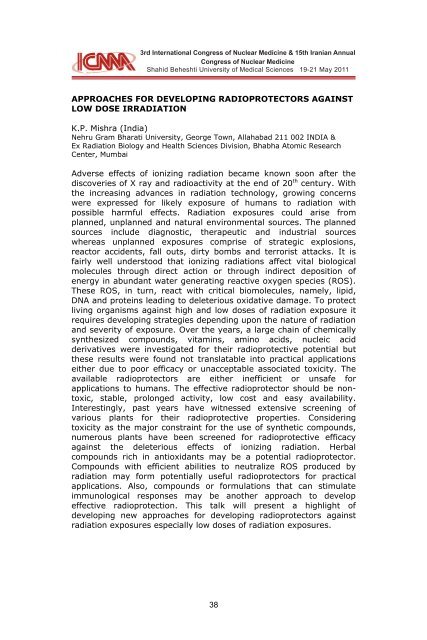Panel Disdussion
Panel Disdussion
Panel Disdussion
You also want an ePaper? Increase the reach of your titles
YUMPU automatically turns print PDFs into web optimized ePapers that Google loves.
3rd International Congress 3rd International of Nuclear Congress Medicine of Nuclear & 15th Medicine Iranian Annual & 15th Iranian Congress Annual of<br />
Nuclear Congress Medicine of Nuclear Medicine<br />
Shahid Beheshti Shahid Beheshti University University of Medical Sciences of Medical 19-21 Sciences May 201119-21 May 2011<br />
APPROACHES FOR DEVELOPING RADIOPROTECTORS AGAINST<br />
LOW DOSE IRRADIATION<br />
K.P. Mishra (India)<br />
Nehru Gram Bharati University, George Town, Allahabad 211 002 INDIA &<br />
Ex Radiation Biology and Health Sciences Division, Bhabha Atomic Research<br />
Center, Mumbai<br />
Adverse effects of ionizing radiation became known soon after the<br />
discoveries of X ray and radioactivity at the end of 20 th century. With<br />
the increasing advances in radiation technology, growing concerns<br />
were expressed for likely exposure of humans to radiation with<br />
possible harmful effects. Radiation exposures could arise from<br />
planned, unplanned and natural environmental sources. The planned<br />
sources include diagnostic, therapeutic and industrial sources<br />
whereas unplanned exposures comprise of strategic explosions,<br />
reactor accidents, fall outs, dirty bombs and terrorist attacks. It is<br />
fairly well understood that ionizing radiations affect vital biological<br />
molecules through direct action or through indirect deposition of<br />
energy in abundant water generating reactive oxygen species (ROS).<br />
These ROS, in turn, react with critical biomolecules, namely, lipid,<br />
DNA and proteins leading to deleterious oxidative damage. To protect<br />
living organisms against high and low doses of radiation exposure it<br />
requires developing strategies depending upon the nature of radiation<br />
and severity of exposure. Over the years, a large chain of chemically<br />
synthesized compounds, vitamins, amino acids, nucleic acid<br />
derivatives were investigated for their radioprotective potential but<br />
these results were found not translatable into practical applications<br />
either due to poor efficacy or unacceptable associated toxicity. The<br />
available radioprotectors are either inefficient or unsafe for<br />
applications to humans. The effective radioprotector should be nontoxic,<br />
stable, prolonged activity, low cost and easy availability.<br />
Interestingly, past years have witnessed extensive screening of<br />
various plants for their radioprotective properties. Considering<br />
toxicity as the major constraint for the use of synthetic compounds,<br />
numerous plants have been screened for radioprotective efficacy<br />
against the deleterious effects of ionizing radiation. Herbal<br />
compounds rich in antioxidants may be a potential radioprotector.<br />
Compounds with efficient abilities to neutralize ROS produced by<br />
radiation may form potentially useful radioprotectors for practical<br />
applications. Also, compounds or formulations that can stimulate<br />
immunological responses may be another approach to develop<br />
effective radioprotection. This talk will present a highlight of<br />
developing new approaches for developing radioprotectors against<br />
radiation exposures especially low doses of radiation exposures.<br />
38
















